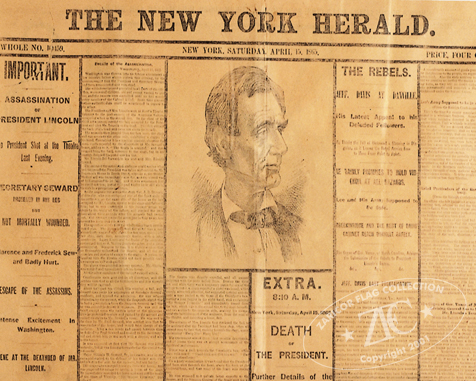
36 Star U.S. "Grand Luminary" - President Abraham Lincoln Mourning Flag.
This 36 star grand luminary flag's history is rich; it was used in Providence, Rhode Island, as a mourning flag after the assassination of Abraham Lincoln. It was formerly part of the acclaimed collection of noted antique dealer Mr. Boleslaw Mastai and his wife Marie-Louise d'Otrange Mastai, formerly of New York City, and later Amagansett, Long Island. Their collection was the result of fifty years of collecting, research and study by the late husband-wife team. Mastai, started collecting in the early 20th century and amassed to greatest private flag collection in the United States; which he detailed in his landmark book The Stars and The Stripes; The American Flag from Birth of the Republic to the Present, published by Alfred Knopf, New York 1973; which was hailed as a revolution and established the American Flag as both folk art and social history.
Although its popularity had waned during the American Civil War, the grand luminary arrangement of the stars to form one great star still held some degree of favor at the end of the Civil War. In this small silk flag, the stars are formed into a large star centered on a star that is slightly larger than the stars composing the points of the great star. All were applied to the light blue silk canton with white paint. A black silk crepe border was added to this flag during the period of official mourning for the death of President Abraham Lincoln, who was assassinated on the evening of April 14th, 1865 and who died the next morning. Flags were placed in mourning, which in Victorian parlance also meant bordering all or some of the edges of a flag in black crepe. Some flags with inked black borders also survive.

Crepe, used to trim flags as a picture frame border, is the fabric most associated with mourning. 19th century Americans were forced to deal with death on a much larger scale than we face today and the War Between the states claimed lives from practically every American family. Death was so prevalent that mourning customs and rituals were refined from several centuries of superstitions and beliefs as a way of showing proper respect for the deceased. These customs called for changes in flags, clothing, home decor and even in one's way of life all of which are today somewhat difficult to comprehend. It was a time when families perhaps needed the support of the community more than at any other time; they were grieving and yet were expected to shoulder the burden of family responsibilities and overwhelming grief. Mourning was a way for individuals to share grief and gain compassion. The same was true of the nation.
According the printed history of this flag this band of crepe, which surrounds the Great star, was never removed, and the flag was used to mourn other assassinated Presidents, including John F. Kennedy.
Exhibition History:
First Presidio Exhibit
(ZFC0617)
36-Star Grand Luminary United States Mourning Flag
Exhibited in The American Flag, I and II
Second Presidio Exhibit, 2003 - GALLERY V
(ZFC0617)
36-Star Grand Luminary United States Mourning Flag
Chicago Meeting December, 2003
(ZFC0617)
36-Star Grand Luminary United States Mourning Flag
University of California - Santa Cruz
Board of Councilors Meeting, 7 June 2012
Rare Flags Exhibit
Publication History:
Madaus, Howard M., Dr, Whitney Smith, The American Flag: Two Centuries of Concord and Conflict. Santa Cruz: VZ Publications, 2006, p. 90-91.
Depicted in Mastai (1973), p. 155.
Depicted in American Flags, p.57.
Depicted in The American Flag, pp. 90-1.
Provenance:
Acquired by Boleslaw Mastai at estate auction in Providence, Rhode Island.
Acquired by the Zaricor Flag Collection (ZFC0617) in 2002 from the Mastai Flag Collection through auction at Sotheby's of New York City.
Deaccessed Heritage Auctions - 13 November 2023 - Auction 6276
ZFC Significant Flag
Item is Framed
Sources: